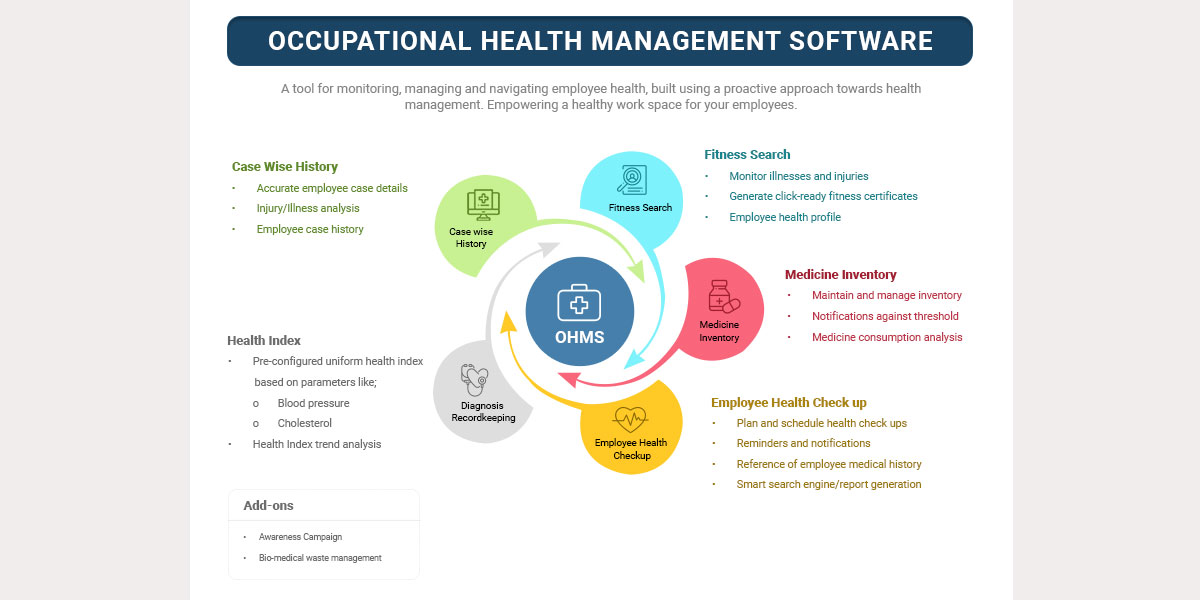How Occupational Health Professionals are using medical and health data (analytics) to define awareness programs, trainings and consultations

Role of a doctor or health professionals in an enterprise environment
An industrial or non-industrial Occupational Health Center (OHC) is pretty similar to a healthcare facility. Most functional responsibilities, protocols and activities remain similar, albeit, in a more focused group capacity in comparison. OHCs are required to be far more focused in their approach to healthcare and the well being of their organization’s employees / stakeholders.
Doctors are, mostly, in-charge of OHCsat most business enterprises. While they take care of patients, they are also responsible for;
- Managing health awareness campaigns
- Health training and consultation
- Monitoring and managing the health of stakeholders
- OHC Administration
Doctors also need data. But why and what type of data helps them?
Usually doctors who are in charge of OHCs, need data to ensure large groups of people are taken care of, in right earnest. They rely on data and analytics for clinical, operational, commercial and administrative improvement. These include;
- Gathering past medical history of employees
- OPD visits for illness or injury
- Routine medical checkups
- Medicine prescription
- Work location specific exposure to various chemical or equipment
- Inventories
- Many others
Collecting data is the first step but it hardly helps in its raw form. A clear process of representing the data, in a manner that helps doctors take important decisions, is required. One needs to centralize data by having a systematic data collection process, storage mechanism and then conduct outcome driven analysis that provides measurable results.
A blog published by the University of Pittsburgh, USA,very aptly describes how doctors use data;
- Descriptive analytics where historical data is used for comparisons and discovering patterns
- Predictive analytics where current and empirical data is used to predict future outcomes
- Prescriptive analytics which is not only used for predictions but also for determining the best course of action
The blog further describes the growing importance of data analysis where data is mined, evaluated and then predictive models are built around it so as to provide decisive insights.
Doctors running OHCs on site can also use data in the same context. OHCs cater to a larger but a more focused audience. While general health facilities face the challenge of data diversity, OHCs have an upper hand, in that they can channel data in the direction that they want to.
For most OHCs, proactive health monitoring and regular checkups allow them to maintain a higher employee health index at the work site. There are quite a few manufacturing / engineering processes that allow them to ascertain certain health irregularities. For e.g. people working in a production unit having loud noises (high decibels) may be facing ENT issues which need to be addressed. But without appropriate data, doctors might not be able to sensitize people to the apparent dangers.
Similarly, accurate medical histories of individuals can help doctors prescribe relevant trainingsso as to mitigate any possible chances of harm/ill health.
Case in point:
When doctors get easy access to such personalized data, they are able to accurately diagnose a problem and provide betterprescriptions / recommendations. So any person having a medical history of bronchitis would be advised to take necessary precautions as per his current work environment. This will potentially, avoid any recurrences of the same in his workplace.
The impact of technology in the health management efforts of OHCs
There’s enough technology available today for assisting doctors with data automation and representation. So much so that the entire process of data mining, evaluation and analysis is automated to a point where doctors are able to provide better prescriptions / consultations. Customization of effective processes, data collection methodologies and data analysis has further lent a great helping hand in the sense that a separate technocrat is no more needed to manage it. Here’s a summary of benefits enjoyed by OHCs having analytical tools at their disposal;
- Proactive health awareness campaigns
- Identifying trends as per work location or age group or category of work and many more
- Planning calendars for health check-ups
- Data driven health indices
- Data visualization and representation for determining health trends
- Statistical & click-ready reports
How do you think data analytics can help your OHC? Write to us with your views / comments:



Data visualization and representation for determining health trends